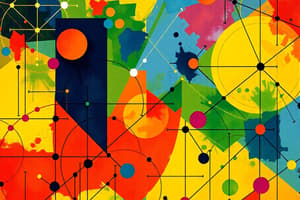Podcast
Questions and Answers
Which branch of mathematics focuses on the study of vector spaces?
Which branch of mathematics focuses on the study of vector spaces?
- Linear Algebra (correct)
- Chaos Theory
- Euclidean Geometry
- Abstract Algebra
Calculus was primarily developed to:
Calculus was primarily developed to:
- Study discrete mathematical structures.
- Establish a rigorous axiomatic framework for mathematics.
- Investigate change and motion. (correct)
- Explore the foundations of set theory.
Which field of mathematics is used to provide a rigorous axiomatic framework?
Which field of mathematics is used to provide a rigorous axiomatic framework?
- Combinatorics
- Mathematical Logic (correct)
- Differential Geometry
- Topology
Which of the following is an area of focus within discrete mathematics?
Which of the following is an area of focus within discrete mathematics?
Which of the following best describes the relationship between pure and applied mathematics?
Which of the following best describes the relationship between pure and applied mathematics?
If a MAPEH teacher is teaching about the use of color to create mood, which area of MAPEH are they most likely covering?
If a MAPEH teacher is teaching about the use of color to create mood, which area of MAPEH are they most likely covering?
If a conjecture in mathematics is proposed, what is required to establish its truth?
If a conjecture in mathematics is proposed, what is required to establish its truth?
Which mathematical discipline focuses primarily on the properties and relationships of integers?
Which mathematical discipline focuses primarily on the properties and relationships of integers?
Which activity best exemplifies the integration of Music and Arts within the MAPEH curriculum?
Which activity best exemplifies the integration of Music and Arts within the MAPEH curriculum?
How did the Renaissance period influence the development of mathematics?
How did the Renaissance period influence the development of mathematics?
Which of these topics is most likely to be covered in the Health component of MAPEH?
Which of these topics is most likely to be covered in the Health component of MAPEH?
A lesson plan involving rhythmic movement and coordination drills would primarily fall under which area of MAPEH?
A lesson plan involving rhythmic movement and coordination drills would primarily fall under which area of MAPEH?
Which of the following is considered a core area within the study of mathematics?
Which of the following is considered a core area within the study of mathematics?
In what way does abstraction contribute to the advancement of mathematics?
In what way does abstraction contribute to the advancement of mathematics?
Understanding the historical context of different art movements is primarily the focus of which area within MAPEH?
Understanding the historical context of different art movements is primarily the focus of which area within MAPEH?
Which of the following activities integrates concepts from both Physical Education and Health within the MAPEH framework?
Which of the following activities integrates concepts from both Physical Education and Health within the MAPEH framework?
Which of the following sequences accurately represents the expansion of number systems in mathematics, from simplest to most complex?
Which of the following sequences accurately represents the expansion of number systems in mathematics, from simplest to most complex?
What distinguishes mathematics from other fields of study?
What distinguishes mathematics from other fields of study?
Flashcards
What is Mathematics?
What is Mathematics?
The study of quantity, structure, space, and change.
What do Mathematicians do?
What do Mathematicians do?
Seeking patterns and formulating new ideas/statements.
Mathematical Proofs
Mathematical Proofs
Verifying the truth or untruth of conjectures using proofs.
Quantity in Math
Quantity in Math
Signup and view all the flashcards
Structure in Mathematics
Structure in Mathematics
Signup and view all the flashcards
Number Systems
Number Systems
Signup and view all the flashcards
Arithmetic
Arithmetic
Signup and view all the flashcards
Number Theory
Number Theory
Signup and view all the flashcards
Abstract Algebra
Abstract Algebra
Signup and view all the flashcards
Space (in Math)
Space (in Math)
Signup and view all the flashcards
Change (in Math)
Change (in Math)
Signup and view all the flashcards
Foundations of Mathematics
Foundations of Mathematics
Signup and view all the flashcards
Discrete Mathematics
Discrete Mathematics
Signup and view all the flashcards
MAPEH
MAPEH
Signup and view all the flashcards
Music Education
Music Education
Signup and view all the flashcards
Visual Arts Education
Visual Arts Education
Signup and view all the flashcards
Physical Education (PE)
Physical Education (PE)
Signup and view all the flashcards
Health Education
Health Education
Signup and view all the flashcards
Study Notes
- Math focuses on quantity, structure, space, and change.
- The philosophy of mathematics offers other perspectives.
- Mathematicians identify patterns and create conjectures.
- Mathematical proofs determine the truth or falsity of conjectures.
- Mathematical reasoning provides insight and predictions about nature when mathematical structures model real phenomena well.
- Abstraction and logic led to mathematics evolving from counting, calculation, measurement, and the study of physical object shapes and motions.
- Practical mathematics has been a human activity since written records began.
- Solving mathematical problems can require years or centuries of research.
- Rigorous arguments were first seen in Greek mathematics, notably in Euclid's Elements.
- Mathematics developed at varying rates until the Renaissance; mathematical innovations combined with scientific discoveries, rapidly increasing mathematical discovery, which continues today.
- Mathematics is vital in natural science, engineering, medicine, finance, and social sciences.
- Applied mathematics has created new mathematical disciplines like statistics and game theory.
- Mathematicians study pure mathematics (mathematics for its own sake) without considering applications.
- Pure and applied mathematics are not clearly divided; practical applications for pure mathematics are often discovered later.
Areas of Mathematics
- Quantity includes numbers and arithmetic.
- Structure includes algebra.
- Space includes geometry.
- Change includes calculus and analysis.
- Mathematical logic and set theory contribute as foundations of mathematics.
- Probability theory, statistics, game theory, and mathematical finance are newer branches.
Quantity
- Deals with numbers, the best-known mathematical objects.
- Extends to number systems like natural numbers, integers, rational numbers, real numbers, and complex numbers.
- Arithmetic includes operations like addition, subtraction, multiplication, division, exponentiation, and root extraction.
- Number theory studies the properties of integers.
- Encompasses Fermat's Last Theorem and the prime number theorem.
Structure
- Focuses on studying relationships.
- Includes algebraic structures like groups, rings, and fields.
- Abstract algebra is a key aspect.
- Vector spaces are studied in linear algebra.
Space
- Geometry is the origin point for studying Space.
- Includes Euclidean geometry, trigonometry, analytic geometry, differential geometry, and topology.
Change
- Understanding and describing change is common in the natural sciences.
- Calculus was created to study change.
- Functions describe changing quantities.
- Differential equations, difference equations, and dynamical systems are studied.
- Chaos theory studies unpredictable systems.
Foundations and Philosophy
- Mathematical logic and set theory were developed to clarify math foundations.
- Mathematical logic establishes a rigorous axiomatic framework for mathematics and studies the results.
- Set theory studies sets, which are collections of objects.
- Type theory is another foundational system.
- Philosophy of mathematics addresses the epistemological status of mathematical statements.
- Poses questions such as: What is a number? What is a mathematical proof?
Discrete Mathematics
- Discrete mathematics studies discrete, rather than continuous, mathematical structures.
- Includes combinatorics, graph theory, and theoretical computer science.
- Used in computer science and operations research.
Music, Arts, Physical Education and Health (MAPEH)
- MAPEH combines Music, Arts, Physical Education, and Health as one subject.
- Aims to give students a complete knowledge and love for the arts, physical activities, and healthy living.
Music
- Music education studies musical elements, history, culture, and performance.
- Students learn about rhythm, melody, harmony, form, and other musical concepts.
- Common activities include singing, playing instruments, composing, and analyzing music.
Arts
- Visual arts education encompasses drawing, painting, sculpture, printmaking, and design.
- Students explore different art styles, techniques, and media.
- Art history and cultural context are studied.
Physical Education
- PE emphasizes physical fitness, sports, and movement skills.
- Students engage in physical activities, games, and exercises.
- They learn about physical health, nutrition, and safety.
Health
- Health education covers personal hygiene, nutrition, disease prevention, mental health, and substance abuse.
- Students learn to make healthy choices and promote well-being.
- Includes reproductive health, first aid, and environmental health.
Integration
- MAPEH is designed as an integrated subject to show discipline connections.
- Music and the arts connect through musical forms and visual art styles.
- Physical education and health connect through promoting physical activity and healthy living.
Studying That Suits You
Use AI to generate personalized quizzes and flashcards to suit your learning preferences.




